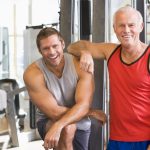
 Okay, so it’s not just the Surgeon General who says walking is good for you…everyone says so! Walking ranks up there with the best form of exercise there is! And it doesn’t cost a thing – bonus!
Okay, so it’s not just the Surgeon General who says walking is good for you…everyone says so! Walking ranks up there with the best form of exercise there is! And it doesn’t cost a thing – bonus!
NFPT supports the Surgeon General’s call to action to ‘Promote Walking and Walkable Communities‘. Specifically, the Surgeon General’s Call to Action includes 5 Goals1. We have listed them here with some of our ideas to further promote and reinforce these valuable efforts.
GOAL 1. Make Walking a National Priority. Through initiatives which demonstrate the already popular notion of ‘walking for exercise’ we can bring more attention to how many people already use walking as their primary means of exercise. For example, the more people who use social media to say that they walked today, then the more that others will be encouraged to do the same. Friends and family will think “hey, that’s easy, I can do that too!” – hopefully they will feel the urge to get out and walk the block.
GOAL 2: Design Communities that Make it Safe and Easy to Walk for People of All Ages and Abilities. Safety and ease of access is a concern for people living in areas where they do not feel comfortable walking at night or in areas where there are limited sidewalks, lighting and places to take long walks. Safety and ease of access includes those rolling wheelchairs who want to enjoy getting physically active within their neighborhood, the pathways and lighting must be offered to do so. If you find that these things are hard to find in your neighborhood, write to your local mayor’s office! Jump on your city’s website and find an email address, it’s easy to do, and it all starts with a simple request. The more people who care, the more that the decision makers will care. Also consider taking a self-defense class; because, whether or not there is a real element of danger or just perceived danger, a self-defense class will help you to trade in your concern for confidence, and enjoy a walk in your neighborhood! I took a self defense class, called RAD (Rape and Aggression Defense), not only because I wanted to feel better about walking at night but because I wanted to take control of the unknown (as much as that is possible) and learn some basic self defense tactics. Personally, I walk with my big dog, no one wants to approach me when I have 100 extra pounds of muscle walking at my side! Now of course that doesn’t work for my mom and her Pomeranian, but the mace in her pocket is a good back up plan.
GOAL 3. Promote Programs and Policies to Support Walking Where People Live, Learn, Work and Play. It is recommended that adults get at least 150 minutes of moderate-intensity aerobic activity (or 75 minutes of high-intensity activity) each week; with children and adolescents it is 60 minutes of activity in some form each day.2 So the easy math on that is 30 minutes of walking a day, 5 days a week; or 21-ish minutes a day spent walking 7 days a week, for adults (with the kiddos, it should be more). Think first about what you’re getting already, by default. For example, are you walking to work? Walking your kids to the school bus stop? (a double bonus there, both you and the kids get some daily walking time). Where and how much do you walk already? Simply add to it. The math flushes out whether you purposefully take a long walk before dinner every night, or you take the long way around the office building every day – both are purposeful efforts and one may fit better into your day to day life. Are you on lunch break for an hour?? Walk the first 30 minutes and then eat your sandwich. A lot of businesses now encourage their employees to walk by providing walking tracks or areas, and some even incentivize walks by giving extra break times for those who use their break time to walk or exercise. If it’s not encouraged by employers, it should be. Walking, healthier employees make for
 productive, happier employees – it just makes sense. Oh, and get your kids away from the TV and their i-DooDads, walk with them to play in the park, walk around the neighborhood and catch up on their lives. A nice long walk with your tween or teen will yield much information that maybe you didn’t know before – another double bonus!
productive, happier employees – it just makes sense. Oh, and get your kids away from the TV and their i-DooDads, walk with them to play in the park, walk around the neighborhood and catch up on their lives. A nice long walk with your tween or teen will yield much information that maybe you didn’t know before – another double bonus!
GOAL 4. Provide Information to Encourage Walking and Improve Walkability. This fits the ‘more you know’ mantra, quite effective, as always. Because, with respect to walking, who would get out there and purposefully walk more every day if they didn’t know how good it was for them?? Only the people who really really want to walk and enjoy walking. You might, I might, but the person who is already at great risk because they don’t take care of themselves would probably not get out and about on the walking track, so they need to know why it matters…and that it does matter. I watched this great video, ’23 and 1/2 hours’, he does a great job of putting it all into perspective. Maybe you’ve seen it. Maybe someone you know, who could really benefit from the information, should see it. Share because you care:
GOAL 5. Fill Surveillance, Research and Evaluation Gaps Related to Walking and Walkability. This goal crosses the border of ‘the more you know’ and moves toward confirming the things that we think we know…making sure that stats are maintained, reliable and relevant. In my view, this means more record keeping, tracking and evaluation of the number of people who walk regularly. This data should be correlated directly to their progressive physical fitness levels and specific factors like frequency and duration. But how in the world do you keep track of all of that?? Well, that data collection could be emphasized and organized by state and local run initiatives which rely on the data of doctors, health care providers and of course…PERSONAL TRAINERS. Now, don’t misconstrue. I am not calling for more regulation, that is something that the people and industries of our highly regulated country need no more of. What I am suggesting is that, with enough health care professionals who are educated on the subject and who care about a walking initiative, data as the result of polling and alternative collections can be a valuable piece to the evaluation puzzle. This first starts with education of the initiative.
 We applaud the Surgeon General and all of those individuals and companies who support the literal strides that this initiative is taking…come on America, walk with your family, walk with your friend, walk with your dog – let’s Step it Up!
We applaud the Surgeon General and all of those individuals and companies who support the literal strides that this initiative is taking…come on America, walk with your family, walk with your friend, walk with your dog – let’s Step it Up!
Go here for specific Walking Advice for your Personal Training Clients.
1 Surgeon General’s Step It Up Call to Action to Promote Walking and Walkable Communities. Executive Summary. Retrieved from http://www.surgeongeneral.gov/library/calls/walking-and-walkable-communities/exec-summary.html
2 U.S. Department of Health and Human Services. 2008 Physical Activity Guidelines for Americans. Washington, DC: U.S. Dept of Health and Human Services; 2008.



